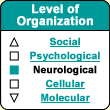|
|
| Funding for this site is provided by readers like you. | |
|
|
|
|
|||||
|
|
|||||||
|
|
|
|
|
|
|
|
People with various anxiety disorders display abnormalities in the size or neural activity of various structures in their brains.
The amygdala is thus ideally positioned to set off the various symptoms of a panic attack. And animal studies have in fact shown that stimulating the central nucleus of the amygdala either electrically or with drugs does in fact produce the behaviours associated with panic.
Other studies indicate that the central grey nuclei, subcortical areas of the brain that are involved in the involuntary component of body movements, are abnormally active in people with obsessive-compulsive disorder. The cortex plays its own significant part in anxiety disorders.
The ventromedial region of the prefrontal cortex, which is recognized
for its role as a modulator of the emotions and for its involvement
in depression, also seems to play a primary role in the process
of extinction that is the basis for many effective therapies for
anxiety disorders. |
|
||||||||||||||||||||||||||||||||||||||||||||||||||||||||||||||||||||
| |
|
|
|
|
|
|
|
|







